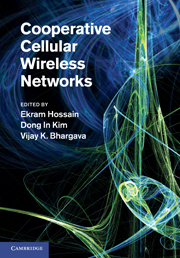Book contents
- Frontmatter
- Contents
- List of contributors
- Preface
- Part I Introduction
- Part II Cooperative base station techniques
- Part III Relay-based cooperative cellular wireless networks
- Part IV Game theoretic models for cooperative cellular wireless networks
- Part V Standardization activities
- 15 Cooperative communications in 3GPP LTE-Advanced standard
- 16 Partial information relaying and relaying in 3GPP LTE
- 17 Coordinated multipoint transmission in LTE-Advanced
- Index
17 - Coordinated multipoint transmission in LTE-Advanced
from Part V - Standardization activities
Published online by Cambridge University Press: 03 May 2011
- Frontmatter
- Contents
- List of contributors
- Preface
- Part I Introduction
- Part II Cooperative base station techniques
- Part III Relay-based cooperative cellular wireless networks
- Part IV Game theoretic models for cooperative cellular wireless networks
- Part V Standardization activities
- 15 Cooperative communications in 3GPP LTE-Advanced standard
- 16 Partial information relaying and relaying in 3GPP LTE
- 17 Coordinated multipoint transmission in LTE-Advanced
- Index
Summary
Introduction
Coordinated multipoint (CoMP) transmission is considered as a promising multiple-input multiple-output (MIMO) technique that can be a primary element for better intercell interference (ICI) control in the next generation cellular networks. The classical MIMO technique uses a colocated antenna array for beamforming to the direction of an intended user while trying to reduce interstream and interuser interference. However, such single-cell MIMO transmissions cause intensified narrow beams and can interfere with other cells' users. In multicell simulations, interference from adjacent cells is even more detrimental. It is found that, depending on the scenario, no less than 30% of the user equipment (UEs) in a cell will have a wideband signal-to-interference-and-noise ratio (SINR) below 0 dB. Various techniques to combat this problem have been proposed by standardization organizations such as 3GPP LTE and IEEE 802.16e/m. Typical examples include sectorization using directional antenna, ICI randomization with interference cancelation at the receiver, and ICI avoidance techniques, such as ICI-aware power control, fractional frequency reuse (FFR), and intercell scheduling. These techniques can be deployed in addition to MIMO but often lead to either loss of average sector throughput or increased receiver complexity. CoMP transmission has been proposed and supported by many companies, including Ericsson, Motorola, Alcatel-Lucent, Huawei, Qualcomm, Samsung, LGE, ETRI, DoCoMO, Nortel, and is believed to be a promising ICI mitigation solution that can improve cell-edge throughput as well as average sector throughput with little complexity increase at the receiver side.
- Type
- Chapter
- Information
- Cooperative Cellular Wireless Networks , pp. 495 - 513Publisher: Cambridge University PressPrint publication year: 2011



